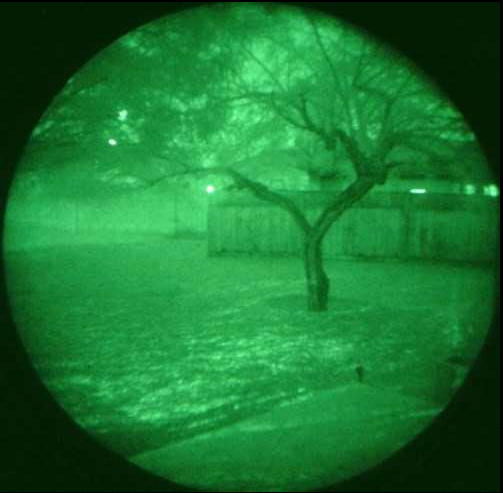It feels like night vision is required when looking into our own life or the life of another. We can make out the shape of some things that seem to be significant in the discovery of who we are, but they remain fairly dim and undefined or can disappear altogether.
I remember several late evenings (actually early mornings) getting up and walking into the kitchen to get a pain reliever for a headache. I would leave the lights off hoping not to wake my wife and avoiding any other reasons for my head to hurt.
As I would walk through the dark living room, I would sometimes catch a glimpse of a pair of shoes or the vacuum cleaner with my peripheral vision. As I tried to focus directly on it, it would often disappear. As soon as I looked straight ahead, I would see it once again. Why?
In the same way, have you ever noticed an airplane or a satellite moving across the dark evening sky and as you attempt to follow it, it disappears? Why?
I found the answer in a firearms training course I recently took, as the instructor talked about dim light shooting and eye sight. I discovered a transcendent truth in a most unlikely place.
The iris is like the shutter of a camera, opening and closing to regulate the amount of light entering the eye though the pupil. When we talk about eye color, we are talking about the iris.
The retina is similar to the film in a camera. The retina is struck by light coming in through the pupil, forming an image, and then causing an impression to be transmitted to the brain through the optic nerve.
The retina is composed of two different types of cells -‐ cone cells and rod cells. The cone cells are your “day eyes” because they require a great deal of light to activate them and they are blind during periods of low-‐illumination. These cells enable you to see color, shape, and contrast.
Your “night eyes” are your rod cells. They produce a chemical substance called visual purple, which makes them active in darkness or periods of low-‐illumination. They enable you to distinguish black, white, and shades of gray, and to distinguish general outlines.
Alright, here is where I’m going with all of this – the principles of night vision.
First, we must give our eyes time to adapt to low levels of illumination. It takes approximately 20-‐30 minutes for the rod cells to produce enough visual purple to activate and enable you to distinguish objects in dim light.
Too often we want instant clarity and when it doesn’t come, we stop looking – we walk away from our search. Clarity always come in degrees and over time. It takes time for the eyes of our heart (Eph. 1:18-‐ 19) to adjust to the often dim light over our story. “People’s thoughts can be like a deep well, but someone with understanding can find the wisdom there.” (Prov. 20:5 NCV) Deep wells are always dark.
Secondly; in dim light, we must keep our attention on an object without looking directly at it. Looking directly at an object focuses the image on the cone region which isn’t sensitive at night. To form the image on the rod cells we need to look slightly to the right, left, below or above an object. The visual purple in the rod cells blacks out in four to ten seconds and you lose sight of the object, so we must move our eyes swiftly so fresh rod cells are used. We must pause for a moment at each point because our eyes can’t see while in motion.
The human heart and the work of God is vast, complex and mysterious. When we focus on one aspect of our heart or life for a long period of time to the exclusion of others, it often becomes imperceptible. Looking around an issue, question or desire often allows it to come into focus. We must continue to scan the landscape of our life and God’s heart.
Thirdly, confidence plays a very important role in our use of night vision. Normally we use our eyes when there is plenty of light and we see sharp outlines and bright colors. When we are in darkness, objects are faint, have no sharp outlines and have little or no color. We must believe what our eyes tell us. We gain confidence by practicing these principles of night vision.
As we are willing to delve into the dimly lit recesses of a person’s story and glory, offering what we see, we will become more comfortable and skilled with our night vision.
“Now we see a dim reflection… All that I know now is partial and incomplete…” (1 Cor. 13:12)
Learning to see better,
Gary



This just happened to me in my search for clarity. Thanks for your life and work. I needed to hear that.:)
Gary – Another thing about night vision.. Learned the hard way in the Army. At night when you’ve been operating in the dark sometimes you might crawl under a poncho or something to keep the light from being exposed so you can look at a map so you can navigate in the dark. When you do this typically you keep your dominant eye closed so as to no ‘loose’ your night vision when you continue your mission out there in the dark… (if you don’t you get to pay that 20 min deficit to the rod cells all over again) I guess what I am saying is this: its important for all of us to be ‘trained’ not only to use but to preserve our night vision because we need it more often than not.
Gary,
Great post and explanation on how to “see” in the dark, and the patience it takes to do this effectively.
“Too often we want instant clarity and when it doesn’t come, we stop looking – we walk away from our search. Clarity always come in degrees and over time. It takes time for the eyes of our heart (Eph. 1:18- ‐ 19) to adjust to the often dim light over our story”
Well said! I appreciate how you bring the natural/practical and pair with Scripture – that’s where the “aha!” really hits. My soul needed this encouragement, and He sent me just before bed. The Father is taking extra special care of my heart in this season of transition, where there is so much dim and a new manner of faith is required. Thanks for being a part of the comfort, brother!
Yeah….just this week started going to the levee (New Orleans…the one that burst during Katrina) a few blocks away to pray. It seems that every aspect of my life now is unclear and cloudy – ZERO CLARITY! So I have been brought back to thought that I need to have a “umbrella” (borrowed from insurance world) trust in God that just trusts the big picture – even when I fail so see any of the little pictures. Thanks.